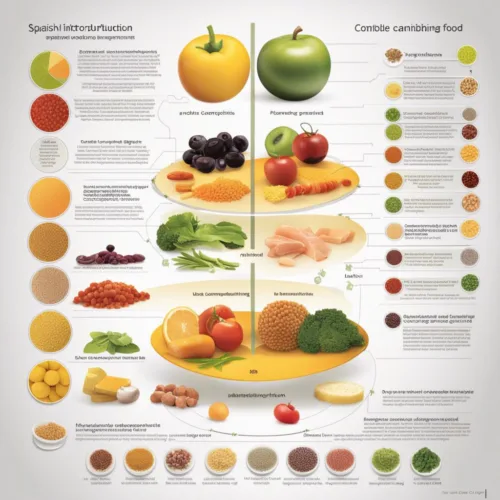Discover how to Food Combining Chart for a healthy life. Learn which foods complement each other and create amazing flavors. Join us on a tasty adventure as we explore the food combining chart.
Now, let’s delve into the exciting world of food combining, and as we explore this concept, we’ll learn how this chart can help us make yummy and nutritious meal choices. To begin with, let’s take a closer look at the different types of food combinations that are recommended for optimal digestion and health.
Table of Contents
- Introduction: Understanding the Science of Food Combining Charts
- Optimal Pairings: Maximizing Nutrient Absorption and Digestion Efficiency
- Compatible and Incompatible Food Combinations: Exploring the Do’s and Don’ts
- Balancing Macronutrients: Combining Proteins, Carbohydrates, and Fats for Optimum Health
- Practical Recommendations: Creating Balanced Meals with an Effective Food Combining Approach
- Q&A
- The Way Forward
Introduction: Understanding the Science of Food Combining Charts

In the food world, there’s a chart called Food Combining that shows how different foods work together in our bodies.
Imagine a group of friends who love to play together. However, certain friends don’t get along well. The same happens with food. Some foods work better when eaten together, while others don’t combine well.
The chart recommends pairing fruits and veggies for good health and advises separating proteins and carbs for better digestion.
Also, Let’s use colors to simplify. Fruits and vegetables are green, and proteins are red. When we eat green and red foods together, it can upset our tummies. But if we eat green foods with green foods or red foods with red foods, our tummies are happy and healthy.
So, The food combining chart helps us make smart food choices. It tells us which foods are best friends and which ones need to stay separate. Following the chart, we can keep our bodies happy and feel good after eating.
Understanding the Science of Food Combining Charts
Listen to your body and eat a balanced diet. The food combining chart is a helpful tool, but it’s not the only thing to consider. Our bodies are unique, so what works for others may not work for us. Find what makes you feel good and healthy.
Let’s imagine a colorful table with two columns. Firstly, in the first column, we’ll list green foods like leafy vegetables, cucumbers, and avocados. Secondly, in the second column, we’ll list red foods like chicken, beef, and fish. This table will help us remember which foods like to play together and which prefer to play alone.
Just like friends who like different games, foods also have different ways of working in our bodies. It’s like a fun puzzle; the food combining chart is our secret map to help us solve it!
Food can be fun and delicious, but it’s also essential to eat foods that make us feel good and keep us healthy. With the help of the food combining chart, we can make smart choices and be superheroes for our bodies!
Optimal Pairings: Maximizing Nutrient Absorption and Digestion Efficiency

Our bodies break down food to extract nutrients with the help of little workers in our tummy. These workers work in pairs to be more efficient, just like good friends. Similarly, some foods are better when eaten together.
Imagine you have LEGO blocks with different colors and shapes. When you build with them, you create amazing structures. Similarly, different foods have unique nutrients our body needs. Combining certain foods is like building a strong structure for our body.
Let’s look at some examples of these optimal pairings:
Spinach is rich in iron, which strengthens our blood. However, our body struggles to absorb all the iron from spinach. Lemon juice contains an acid that helps our body absorb iron more effectively. Therefore, consuming spinach with lemon juice allows our body to obtain more necessary iron.
Beans and rice are a powerful duo. Beans provide protein and rice offers carbohydrates. Together, they fuel our bodies for play and fun, like having two superheroes on our team.
Yogurt has probiotics, little healthy bugs that keep our tummy happy. Berries are full of vitamins and antioxidants that make our body strong. When we eat yogurt and berries together, it’s like a big party for our tummy bugs! They feast and keep our bodies healthy.
Combining foods improves nutrient absorption and enhances body efficiency. Choose food pairs wisely to provide the best tools for your body. Boost nutrients by selecting complementary foods for your meals.
Compatible and Incompatible Food Combinations: Exploring the Do’s and Don’ts

Are you curious about the foods you can eat together and what combinations you should avoid? Well, let me explain it to you in a way that’s easy to understand, just like I would explain it to a 5-year-old.
Some foods are compatible and work well together, while others are incompatible and can cause digestive issues.
Here are some examples of compatible food combinations:
– Fruits and vegetables: Apples and spinach go great together! They both provide vitamins and minerals that are good for your body.
– Proteins and vegetables: Chicken with a side of broccoli is a yummy and healthy combination. It gives you energy and helps you grow strong.
Now, let’s talk about some incompatible food combinations:
- Starches and proteins: It’s not a good idea to have bread with meat in the same meal. Your body has a hard time digesting them together, and it can make you feel uncomfortable.
– Fruits and proteins: Avoid having an orange with your chicken. Fruits and proteins require different enzymes to break them down, and having them together can cause digestion problems.
Remember, it’s essential to listen to your body and pay attention to how different food combinations make you feel. Everyone is different, and what works for one person may not work for another. So, don’t be afraid to experiment and find the food combinations that make you feel your best.
I hope this food combining chart helps you make delicious and healthy choices. Now , you can enjoy your meals while keeping your tummy happy!
Compatible Combinations:
– Fruits and vegetables (e.g., apples and spinach)
– Proteins and vegetables (e.g., chicken and broccoli)
Incompatible Combinations:
– Starches and proteins (e.g., bread and meat)
– Fruits and proteins (e.g., orange and chicken)
Remember to listen to your body and find what works best for you!
Balancing Macronutrients: Combining Proteins, Carbohydrates, and Fats for Optimum Health

Food combining is a strategy that involves pairing different types of nutrients in our meals to promote optimum health. Combining proteins, carbohydrates, and fats in the right proportions ensures that our bodies receive the necessary nutrients for growth and energy. Additionally, this approach can also help improve digestion and reduce discomfort after meals.
In a food combining chart, we can see how different foods fit into these three macronutrient categories. Let’s take a look at an example:
Proteins are vital for our bodies, aiding in growth, repair, and energy. Good sources include lean meats, eggs, dairy, beans, and tofu. When combining proteins with other nutrients, choose healthy options and limit fried or processed meats.
To begin with, carbohydrates provide energy and include foods like bread, rice, pasta, and cereals. However, whole grain options, like whole wheat bread or brown rice, are healthier as they have more fiber and nutrients. In addition, pairing carbohydrates with proteins helps maintain steady blood sugar levels and sustained energy throughout the day.
Fats are needed for vitamin absorption and energy. Choose healthy fats like avocados, nuts, and olive oil instead of saturated and trans fats found in fried foods and processed snacks. Combining healthy fats with proteins and carbs is important for a balanced diet.
By balancing these macronutrients in our meals, we provide our bodies with various nutrients to support growth, energy, and overall health. Remember, it’s essential to include a variety of foods from each category to ensure we receive all the necessary nutrients for our bodies to function correctly.
Practical Recommendations: Creating Balanced Meals with an Effective Food Combining Approach

When it comes to food, it’s essential to eat various things to ensure our body gets all the nutrients it needs. One way to do this is by creating balanced meals with an effective food-combining approach. But what does that mean? Let me explain it to you like you’re 5 years old!
Picture a plate of food. It’s like a stage where various types of food unite to provide you with energy and aid in your growth. Just like in a play, certain food combinations work better than others.
To aid digestion, it is recommended to separate protein foods (such as meat, chicken, fish, or beans) from starchy foods (like rice, pasta, or bread). This is because proteins require a specific environment in the stomach, and starchy foods can hinder their digestion. To ensure optimal digestion and nutrient absorption, it’s important to pay attention to how you combine different types of foods in your meals.
To get the most benefits from fruits, eat them separately or as a snack between meals or after your main course.
Pair your vegetables with any dish. They provide vitamins, and fiber, and keep your tummy healthy. So, have veggies with meat, chicken, fish, or beans.
To help you remember these rules, here’s a food combining chart:
– Proteins (meat, chicken, fish, beans) should be separated from starchy foods (rice, pasta, bread).
– Fruits are best eaten on their own or away from other foods.
– Pair your vegetables with any main dish.
Remember, eating a balanced meal with the right food combinations can make you feel great and keep you healthy. So, next time you sit down to eat, think about what foods go well together and create a delicious and nutritious meal on your little stage!
Q&A
Q: What is a food combining chart, and how does it work?
A food combining chart is a visual guide that helps individuals understand which foods can be combined for optimal digestion and nutrient absorption. It categorizes foods into groups and provides suggestions on how to combine them for improved digestive efficiency. Following the chart, individuals can make informed choices about which foods to eat together and which combinations to avoid. [1]
Q: What are the benefits of following a food combining chart?
A food combining chart can improve digestion, reduce bloating and gas, enhance nutrient absorption, aid in weight management, and boost energy levels. However, scientific evidence supporting these claims is limited, and consulting a healthcare professional or dietitian is recommended for personalized advice. [1]
Q: Are there any specific food combinations that should be avoided?
A: Though lacking scientific evidence, food combining may cause digestion issues for some. Avoid mixing proteins with starchy carbs, like meat with rice or bread, as it can be difficult to digest. Certain individuals may benefit from not combining fruits with other foods, as they digest quickly and may ferment when mixed with slow-digesting foods. Experiment and listen to your body, as tolerance and digestion differ. [1]
Q: Can a food combining chart help with weight loss?
A: Limited evidence supports food combining for weight loss. Calorie intake, macronutrient distribution, and metabolism matter. A food combining chart may help make healthier choices, but a calorie deficit from a balanced diet and exercise is needed. Seek guidance from a dietitian for personalized advice.
The Way Forward
The food chart helps optimize digestion and nutrient absorption. Knowing food compatibility and its effect on digestion helps make better meal choices. This knowledge improves overall health. Proper meal sequencing is crucial for optimal digestion. Use the chart when planning meals for mindful food combinations. “Let food be thy medicine and medicine be thy food” – start maximizing wellness today. [[1] [[2]
Tags: balanced diet, chart, digestion, digestive system, food combinations, food combining, food groups, healthy eating, meal planning, nutritional benefits
